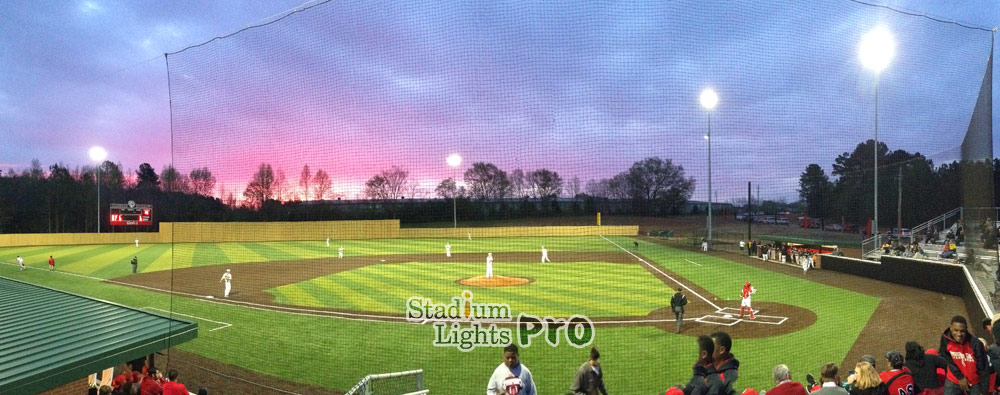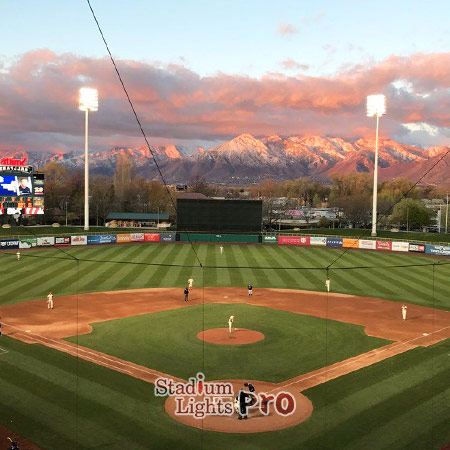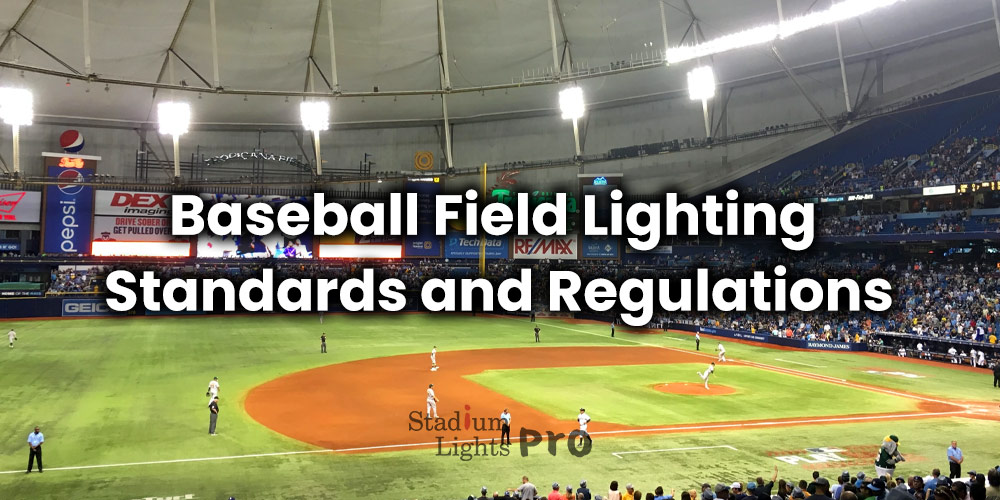Baseball field lighting standards and regulations ensure that players, coaches, and spectators have safe and adequate lighting during games and practices. These standards and regulations cover various aspects of lighting, including intensity, uniformity, placement, glare control, and maintenance. The specific requirements may vary depending on the level of play (e.g. professional, amateur, youth), and may be set by governing bodies such as Major League Baseball or local leagues and organizations.
Adhering to these standards and regulations is essential for player safety, as well as the overall quality of the viewing experience for spectators. Modern baseball field lighting systems are often required to meet energy efficiency standards and may be subject to environmental impact regulations.
Table of Contents
ToggleRequirements for lighting intensity and uniformity
Minimum lighting levels for different levels of play

There are different minimum lighting levels for baseball fields depending on the level of play. These levels are typically measured in lux, which is a unit of luminous intensity. Here are some general guidelines for minimum lighting levels at different levels of play:
Professional
The minimum lighting level for professional baseball fields is typically set at 1,000 lux. This level is intended to provide adequate lighting for players to see the ball and make plays, as well as for spectators to see the action on the field. Some professional stadiums may have lighting levels that exceed this minimum requirement, depending on the specific needs of the team and the preferences of the stadium.
College
The minimum lighting level for college baseball fields is typically set at 500 to 750 lux. This level is generally sufficient for players to see the ball and make plays, and for spectators to follow the action on the field.
High school
The minimum lighting level for high school baseball fields is typically set at 500 lux.
Youth/amateur
The minimum lighting level for youth and amateur baseball fields is typically set at 300 lux.
Baseball infield vs outfield lighting standards
The lux level is typically higher in the infield (around the bases and home plate) than in the outfield, as the infield requires more precise lighting for players to make plays and see the ball. Here are some general guidelines for minimum lux levels on a baseball field:
| Area | Illuminance |
| Infield | 500-1,000 lux |
| Outfield | 200-500 lux |
These are general guidelines and the actual minimum lux levels may vary depending on the specific governing body or organization. Besides, the minimum lux levels may be higher for night games compared to day games, as the lower light levels at night may require additional lighting to ensure adequate visibility.
Regulations for lighting uniformity across the baseball field
Lighting uniformity is a crucial factor in ensuring the safety and visibility of players on a baseball field. Regulations for lighting uniformity typically specify the maximum allowable difference in lighting levels between different areas of the field, such as the infield and the outfield. This helps to ensure that players have consistent visibility and are not disadvantaged by uneven lighting.
Maximum allowable difference in lighting levels between the infield and the outfield
Regulations for lighting uniformity often specify the maximum allowable difference in lighting levels between the infield and the outfield. This helps to ensure that players have consistent visibility and are not disadvantaged by uneven lighting. A common guideline for this difference is 50%, meaning that the lighting level in the outfield can be up to 50% lower than the lighting level in the infield.
Maximum allowable difference in lighting levels between the home plate area and the rest of the field
Regulations for lighting uniformity may also specify the maximum allowable difference in lighting levels between the home plate area and the rest of the field. This helps to ensure that players have consistent visibility and are not disadvantaged by uneven lighting. A common guideline for this difference is 25%, meaning that the lighting level in the home plate area can be up to 25% higher than the lighting level in the rest of the field.
Placement and positioning of baseball stadium lights
Minimum distances from the field for light poles

The minimum distance from the stadium for light poles is typically specified in regulations to ensure the safety of players and to prevent interference with gameplay. The specific distance requirements may vary depending on the height and type of light poles, as well as the level of play (e.g. professional, amateur, youth).
| Level of competition | Minimum distance from the baseball field and light poles |
| Professional | 50-100 feet |
| College | 40-80 feet |
| High school | 30-60 feet |
| Youth/amateur | 20-50 feet |
Height of light poles and fixtures
The specific height requirements may vary depending on the level of play (e.g. professional, amateur, youth) and the specific needs and preferences of the team or organization.
| Level of competition | Baseball field light pole height guideline |
| Professional | 80-100 feet |
| College | 70-90 feet |
| High school | 60-80 feet |
| Youth/amateur | 50-70 feet |
Angle and direction of light fixtures
The specific requirements for the angle and direction of light fixtures may vary depending on the level of play (e.g. professional, amateur, youth) and the specific needs and preferences of the team or organization. Here are some general guidelines for the angle and direction of light fixtures on a baseball field:
Angle
Light fixtures should be angled downward at a steep enough angle to minimize glare and shadow on the field. A common guideline is to angle the fixtures at least 60 degrees downward from horizontal.
Direction
Light fixtures should be pointed towards the center of the field to provide even lighting across the entire playing surface. The fixtures should also be positioned to minimize shadows on the field, such as by avoiding positioning them directly behind the pitcher’s mound.
Glare and reflection control
Measures to reduce glare and reflection on the baseball field
 Excessive glare and reflection on a baseball field can interfere with the visibility and safety of players and may also impact the viewing experience for spectators. There are several measures that can be taken to reduce glare and reflection on the field:
Excessive glare and reflection on a baseball field can interfere with the visibility and safety of players and may also impact the viewing experience for spectators. There are several measures that can be taken to reduce glare and reflection on the field:
Use fixtures with low-glare lenses or shields
Light fixtures with lenses or shields that are designed to reduce glare can help minimize the amount of direct light that reaches the field.
Angle the fixtures downward
Angling the light fixtures downward at a steep angle can help reduce the amount of light that is reflected off the field surface.
Use fixtures with a lower color temperature
Light fixtures with a lower color temperature (e.g. 2700K) tend to produce less glare than fixtures with a higher color temperature (e.g. 5000K).
Use fixtures with a lower luminous intensity
Light fixtures with a lower luminous intensity (measured in lumens) may produce less glare than fixtures with a higher luminous intensity.
Use matte or non-reflective surfaces on the field
Using matte or non-reflective surfaces on the field, such as a grass or dirt surface, can help reduce the amount of light that is reflected off the field.
Implementing these measures can help reduce the amount of glare and reflection on the field and improve the visibility and safety of the players, as well as the overall quality of the viewing experience for spectators.
Regulations for light fixture shielding and shielding materials
Light fixture shielding is the use of materials or devices to block or redirect the light emitted by a light fixture, typically to reduce glare and improve the overall lighting quality. Shielding materials and devices can include lenses, shields, louvers, and other types of reflectors or diffusers.
There are typically regulations in place that specify the requirements for light fixture shielding and the types of materials and devices that can be used. These regulations may vary depending on the level of play (e.g. professional, amateur, youth) and the specific needs and preferences of the team or organization. Here are some general guidelines for light fixture shielding and shielding materials:
- Light fixtures should be equipped with shielding materials or devices to reduce glare and improve the overall lighting quality.
- The shielding materials or devices should be designed to minimize the amount of direct light that reaches the field, while also ensuring that the necessary amount of light is provided for gameplay.
- The shielding devices should be made of durable materials that are resistant to damage and wear.
- They should be properly maintained and replaced as needed to ensure that they continue to function effectively.
Maintenance and repair of baseball field lighting systems
Frequency of light bulb replacement
The frequency of light bulb replacement on a baseball field will depend on the type of light bulbs being used and the specific requirements of the governing body or organization. Some factors that can affect the frequency of light bulb replacement include the intensity of use, the quality of the light bulbs, and the ambient conditions (such as temperature and humidity).
Here are some general guidelines for the frequency of light bulb replacement on a baseball field:
Metal halide light bulbs
These light bulbs typically have a lifespan of 10,000-20,000 hours and should be replaced every 2-5 years.
High-pressure sodium light bulbs
These light bulbs typically have a lifespan of 12,000-24,000 hours and should be replaced every 2-5 years.
LED light bulbs
These light bulbs typically have a longer lifespan than metal halide or high-pressure sodium light bulbs and may last for 100,000 hours or more. LED light bulbs should be replaced every 5-10 years, depending on the intensity of use and the specific requirements of the governing body or organization.
Requirements for testing and inspecting lighting systems
Baseball field lighting systems should be tested and inspected on a regular basis to ensure that they are functioning properly and meeting the required standards and regulations. Testing and inspecting the lighting system can help identify any issues or problems that may need to be addressed, such as faulty light bulbs, damaged fixtures, or wiring issues.
Here are some general guidelines for testing and inspecting baseball field lighting systems:
- The lighting system should be tested and inspected before the start of the season and at regular intervals throughout the season.
- The lighting system should be tested and inspected by a qualified electrician or lighting specialist, using appropriate testing equipment, such as a light meter or other measuring device.
- Any issues or problems that are identified during the testing and inspection process should be promptly addressed and corrected.
Procedures for repairing and maintaining lighting systems
Baseball lighting systems should be regularly maintained and repaired to ensure that they are functioning properly and meeting the required standards and regulations. Here are some general procedures for repairing and maintaining baseball lighting systems:
Identify any issues or problems with the lighting system
The first step in repairing and maintaining the lighting system is to identify any issues or problems that may need to be addressed. This may involve performing routine inspections or testing of the lighting system using appropriate equipment, such as a light meter or other measuring device.
Repair or replace faulty or damaged components
If any issues or problems are identified during the inspection or testing process, the next step is to repair or replace any faulty or damaged components. This may involve replacing light bulbs, repairing or replacing damaged fixtures, or addressing any wiring issues.
Clean and maintain the lighting system
Regular cleaning and maintenance of the lighting system can help ensure that it is functioning properly and efficiently. This may involve cleaning the fixtures, replacing any worn or damaged parts, and adjusting the fixtures as needed to maintain proper aiming and alignment.
Test and inspect the lighting system
After any repairs or maintenance have been completed, we may test and inspect the lighting system to ensure that it is functioning properly and meeting the required standards and regulations.
Following these procedures can help ensure that the lighting system is properly repaired and maintained, which can improve the visibility and safety of the players, as well as the overall quality of the viewing experience for spectators.
Other considerations
Environmental impact of lighting systems
Lighting systems can have an environmental impact in several ways, including energy use, light pollution, and waste generation. Here are some ways in which lighting systems can have an environmental impact:
Energy use
Lighting systems can be a significant source of energy consumption, particularly in large facilities such as baseball stadiums. Using energy-efficient light bulbs and fixtures can help reduce the energy use of a lighting system and lower its carbon footprint.
Light pollution
Lighting systems can contribute to light pollution, which is the excessive or inappropriate use of artificial light that can disrupt the natural day-night cycle and interfere with the behavior of plants and animals. Using lighting controls and shielding materials or devices can help reduce light pollution from lighting systems.
Waste generation
Lighting systems can generate waste, including used light bulbs and other hazardous materials, that can be difficult to dispose of safely. Properly disposing of these materials and using recycling programs can help reduce the waste generated by lighting systems.
Energy efficiency regulations
Energy efficiency regulations are laws or guidelines that set standards for the energy efficiency of products, buildings, and systems. These regulations are often put in place to reduce energy consumption and greenhouse gas emissions, which can have environmental and economic benefits.
There are various types of energy efficiency regulations that may apply to lighting systems, depending on the location and the specific requirements of the governing body or organization. Some examples of energy efficiency regulations that may apply to baseball field lighting systems include:
Energy Star
Energy Star is a program run by the US Environmental Protection Agency (EPA) that sets standards for energy-efficient products, including lighting systems.
Title 24
Title 24 is a set of energy efficiency standards for buildings in the state of California. These standards include requirements for lighting systems in buildings.
International Energy Conservation Code (IECC)
The IECC is a set of energy efficiency standards for buildings that is adopted by many states in the US. These standards include requirements for lighting systems in buildings.
European Union (EU) energy efficiency regulations
The EU has a number of energy efficiency regulations that apply to lighting systems, including the Eco-Design Directive and the Energy Labelling Directive.
Safety considerations
There are several safety considerations to keep in mind when designing, installing, and operating a lighting system on a baseball field. Some of these safety considerations include:
Electrical safety
We need to ensure that the lighting system is properly installed and maintained to minimize the risk of electrical accidents or fires. This may involve following proper electrical codes and guidelines and using qualified electricians to install and maintain the lighting system.
Structural safety
The baseball stadium lighting system should be designed and installed to ensure that it is structurally stable and capable of withstanding the forces that it may be subjected to, such as wind, snow, and impact.
Glare and shadow
Excessive glare or shadow on the field can interfere with the visibility and safety of players and may also impact the viewing experience for spectators. It’s essential to design and install the lighting system in a way that minimizes glare and shadow on the field.
Light pollution
The lighting system should be designed and installed to minimize light pollution, which is the excessive or inappropriate use of artificial light that can disrupt the natural day-night cycle and interfere with the behavior of plants and animals.
Conclusion
Baseball field lighting systems play an essential role in ensuring the visibility and safety of players and spectators during games and practices. There are various standards and regulations in place that govern the design, installation, and operation of these lighting systems, including requirements for lighting levels, lighting uniformity, light fixture shielding and materials, and light bulb replacement. Ensuring that the lighting system meets these standards and regulations can help improve the visibility and safety of players, as well as the overall quality of the viewing experience for spectators.
Thank you for considering us for information on baseball field lighting standards and regulations. If you would like to learn more about these guidelines, or if you need help with lighting design, please don’t hesitate to reach out to us. We would be more than happy to provide you with additional information and assistance.
Our team of lighting experts is here to help ensure that your baseball field lighting system meets all necessary standards and regulations, while also considering the safety and environmental impacts of the lighting system. We offer free lighting design services to help you create a lighting system that meets the specific needs of your team or organization. Contact us today to get started on designing a safe, energy-efficient, and effective lighting system for your baseball field.

